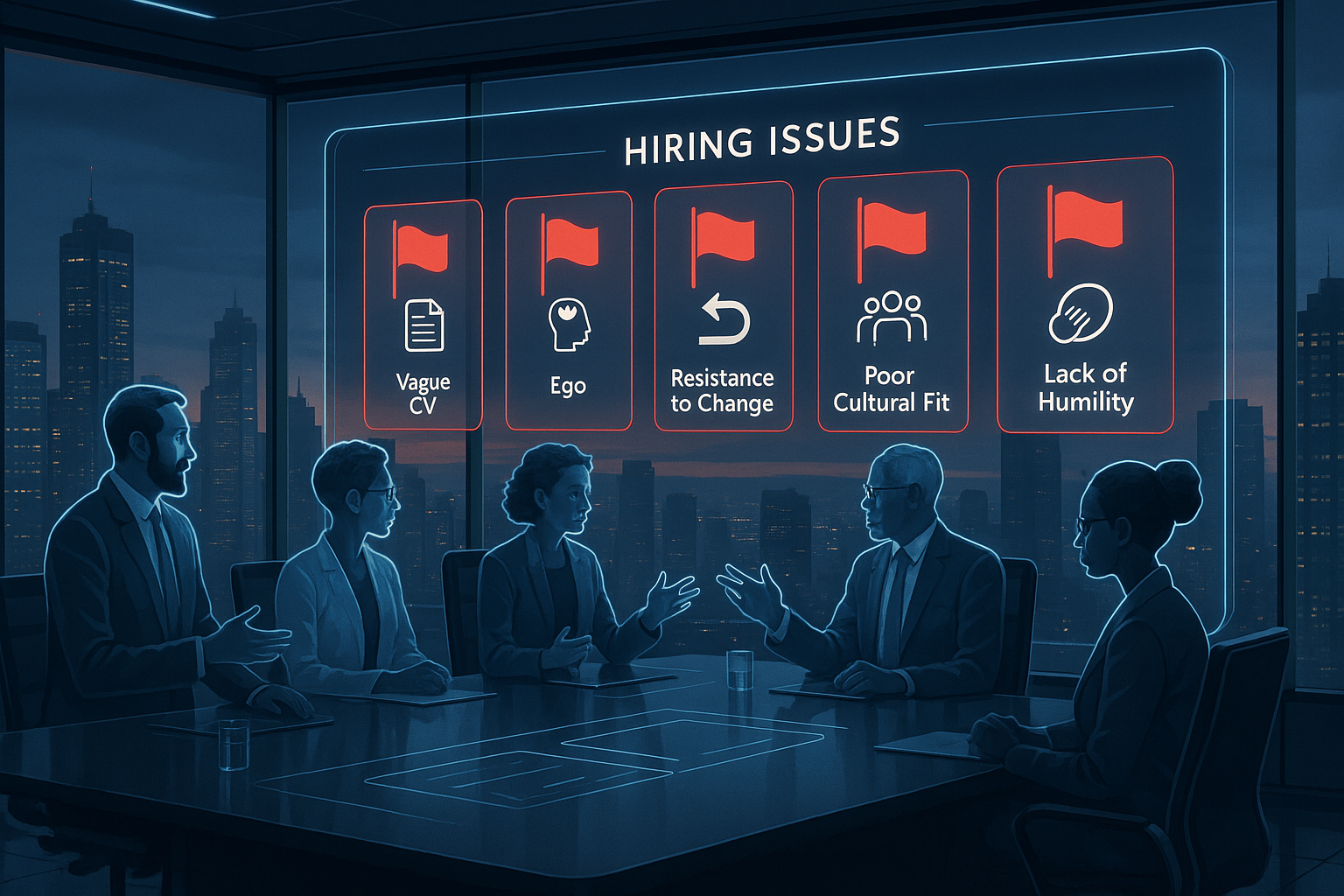🚩5 Red Flags to Watch for When Hiring a Senior Leader (and How to Avoid Them)
🚩5 Red Flags to Watch for When Hiring a Senior Leader (and How to Avoid Them)

Hiring a senior leader is a defining moment for any organisation. Whether you are looking for a new C-suite executive, divisional head or a transformational director, the impact of your decision can resonate across strategy, culture, and long-term performance. Getting it right can accelerate growth and innovation. Getting it wrong can be costly financially, culturally and operationally.
While experience and credentials often take centre stage, there are critical warning signs that should not be overlooked during the recruitment process. Below are five red flags to watch for when hiring a senior leader, along with practical guidance on how to mitigate the risk.
1. Vague or Over-Polished Career Story
One of the most common red flags is a career narrative that sounds too rehearsed or lacks clarity. A candidate who is unable to explain career transitions, glosses over employment gaps, or offers generalised statements without substance may be avoiding important details.
How to Avoid It
Dig deeper into the "why" behind each move. Ask open-ended questions that explore decision-making, challenges faced and lessons learned. Encourage the candidate to share specific outcomes rather than high-level soundbites. Authentic leaders are willing to speak openly about both achievements and setbacks.
2. Overemphasis on Personal Achievement Without Team Recognition
Senior leadership is never a solo act. Be cautious of candidates who repeatedly use “I” instead of “we”, and fail to recognise the teams, mentors or cross-functional collaborators who contributed to their success. A leader who does not credit others may struggle to build high-performing, empowered teams.
How to Avoid It
Ask for examples of how they have developed talent, resolved conflict within teams, or fostered collaboration across departments. Look for signs that they value inclusion, psychological safety, and the growth of others around them.
3. Resistance to Change or Limited Adaptability
In today’s dynamic environment, the ability to adapt and lead through change is essential. A candidate who clings to legacy approaches, dismisses modern practices, or expresses discomfort with ambiguity may not be equipped to lead in a constantly evolving landscape.
How to Avoid It
Present hypothetical change scenarios or reflect on recent changes your organisation has undergone. Ask how they would approach the transition, and whether they’ve led transformations themselves. Strong leaders are not only comfortable with change, they help others navigate it too.
4. Poor Cultural Fit and Lack of Alignment with Values
A senior leader sets the tone from the top, so cultural misalignment can be deeply disruptive. If a candidate appears disinterested in your organisation’s mission, values or working style, or seems out of sync with your leadership team’s ethos, this could pose serious long-term risks.
How to Avoid It
Include people from across the organisation in the interview process, not just the board or HR. Observe how the candidate interacts with diverse stakeholders. Ask value-based questions such as, “What type of organisational culture brings out your best?” or “What behaviours do you model for your team?” Their answers will reveal alignment (or misalignment) with your environment.
5. Overconfidence Without Humility or Self-Awareness
Confidence is important in a senior leader but it must be grounded in humility. Watch for individuals who struggle to admit mistakes, shift blame, or avoid discussing past failures. A lack of self-awareness can be dangerous in leadership, particularly during times of crisis or transformation.
How to Avoid It
Ask directly about a time they made a mistake or received tough feedback. The best leaders will speak honestly, explain how they handled the situation, and share what they learned. True leadership is marked by the ability to own challenges and grow from them.
Conclusion
Hiring at the senior level is not just a recruitment decision, it’s a strategic investment. While impressive CVs and interview presence matter, paying attention to these subtle but telling red flags can help you avoid costly mis-hires. Prioritise authenticity, alignment, adaptability, and emotional intelligence as much as you do experience.
If you are currently navigating a senior hire or planning your leadership succession strategy, we’re here to help.
👉Get in touch for tailored support on executive hiring and leadership assessment (Contact Us>>).



